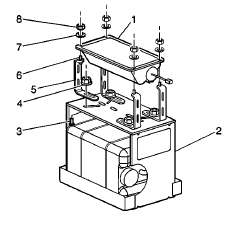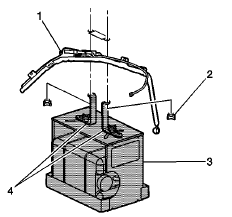Chevrolet Cruze Repair Manual: Deployment Outside Vehicle - Steering Wheel Module, Instrument Panel Module, and Roof Rail Module
Deploy the inflator module outside of the vehicle when the vehicle will be returned to service. Situations that require deployment outside of the vehicle include the following:
- Using the SIR diagnostics, you determine that the inflator module is malfunctioning
- The inflator module is cosmetically damaged, scratched, or ripped.
- The inflator module pigtail is damaged.
- The inflator module connector is damaged.
- The inflator module connector terminals are damaged.
Deployment and disposal of a malfunctioning inflator module is subject to any required retention period.
Warning: Refer to SIR Inflator Module Disposal Warning in the Preface section.
- Turn OFF the ignition.
Warning: Refer to SIR Inflator Module Handling and Storage Warning in the Preface section.
- Remove the inflator module.

- Clear a space on the ground about 1.85 m (6 ft) in diameter for deployment of the inflator module or deployment fixture. If possible, use a paved, outdoor location free of activity. Otherwise, use a space free of activity on the shop floor. Ensure you have sufficient ventilation.
- Clear the area of loose or flammable objects.
Note: Dual stage deployments are only used in steering wheel and instrument panel air bag modules. If stage 1 was used to de ploy a dual stage inflator module, stage 2 may still be active. If disposal of a dual stage module is required, both deployment loops mu st be energized to deploy the air bag.
- If you are deploying a steering wheel inflator module, place the
inflator module in the center of the space with the vinyl trim co
ver
facing up and away from the surface.

- When deploying an instrument panel air bag module, perform the following instructions:
6.1. Place the EL-39401-B fixture in the center of the cleared area.
6.2. Fill the deployment fixture with water or sand.
6.3. Using the proper nuts and bolts, mount the instrument panel air bag module (1) to the deployment fixture (2), with the vinyl trim facing up.
6.4. Securely tighten all fasteners that hold the instrument panel air bag
module (1) to the deployment fixture (2).
- When deploying a roof rail module, perform the following instructions:
7.1. Place the EL-39401-B fixture (3) in the center of the cleared area.
7.2. Fill the deployment fixture with water or sand to provide sufficient stabilization of fixture during deployment.
7.3. Adjust and secure the fixture arms (4) to the deployment fixture (3), using the proper nuts and bolts.
7.4. Attach the roof rail module in the deployment fixture and securely tighten
all fasteners. 
- Inspect the EL-38826 harness and the appropriate pigtail adapter (2) for damage. Replace as needed.
- Short the 2 SIR deployment harness leads (1) together using one banana plug seated into the other.
- Connect the appropriate pigtail adapter (2) to the SIR deployment
harness (1).

- Extend the SIR deployment harness and adapter to the full length from
the deployment fixture or area.

Note: On a dual stage inflator module, both connectors must be attached to the deployment harness adapter. This will ensure that both stage 1 and stage 2 of the deployment loops are energized, regardless of the deployment state.
- Connect the inflator module (1) to the adapter (2) on the SIR deployment harness (3).
Note:
- The rapid expansion of gas involved with deploying an inflator module is very loud. Notify all the people in the immediate area that you intend to deploy the inflator module.
- When the inflator module deploys, the deployment fixture may jump about 30 cm (1 ft) vertically. This is a normal reaction of the inflator module due to the force of the rapid expansion of gas inside the inflator module.
- If you are deploying a dual stage inflator module with stage 1 already deployed, the fixture may not move and the noise may have been reduced
- Clear the area of people.

- Separate the 2 banana plugs on the SIR deployment harness that were
shorted together earlier in the procedure.

- Place a 12 V minimum/2A minimum power source, such as a vehicle battery, near the shorted end of the harness.
- Connect the SIR deployment harness wires to the power source. Deployment
of the Inflator module will occur when contact is made.

- Disconnect the SIR deployment harness from the power source after the inflator module deploys.
- If the inflator module did not deploy, disconnect the adapter and discontinue the procedure and contact the Technical Assistance Group.
If deployment was successful, proceed to the following steps.
Warning: Refer to SIR Deployed Inflator Modules Are Hot Warning in the Preface section.
- Seat one banana plug into the other in order to short the deployment harness leads.
- Put on a pair of shop gloves.
- Disconnect the pigtail adapter from the inflator module as soon as possible.
- Inspect the pigtail adapter and the SIR deployment harness. Replace as needed.
- Dispose of the deployed inflator module through normal refuse channels.
- Wash your hands with a mild soap.
 Inflatable Restraint Module Handling and Scrapping
Inflatable Restraint Module Handling and Scrapping
Special Tools
EL-38826 SIR Deployment Harness
EL-39401-B SIR Deployment Fixture
For equivalent regional tools, refer to Special Tools.
Live and Undeployed Inflator Module
Warning: Refer to ...
 Deployment Inside Vehicle - Vehicle Scrapping Procedure
Deployment Inside Vehicle - Vehicle Scrapping Procedure
Deploy the inflator modules inside of the vehicle when destroying the vehicle
or when salvaging the vehicle for parts. This includes, but is
not limited to, the following situations:
The vehicl ...
Other materials:
Removal Procedure
Warning: Refer to Approved Equipment for Collision Repair Warning in the
Preface section.
Warning: Refer to Collision Sectioning Warning in the Preface section.
Warning: Refer to Glass and Sheet Metal Handling Warning in the Preface section.
Disable the SIR System. Refer to SIR Dis ...
Exterior Lighting Systems Description and Operation
Exterior Lamps
The exterior lighting system consists of the following lamps if equipped:
Headlamps
Daytime Running Lamps (DRL)
Front fog lamps
Rear fog lamps
Park, tail and license lamps
Turn signal lamps
Hazard warning lamps
Repeater lamps
Stop lamps
Backup lamps
Low Beam ...
Rear Bumper Fascia Replacement
Preliminary Procedure
Remove the tail lamps. Refer to Tail Lamp Replacement.
Rear Bumper Fascia Retainer (Qty: 2)
Rear Wheelhouse Liner Bolt (Qty: 6)
Caution: Refer to Fastener Caution in the Preface section.
Tighten
2.5 N·m (23 lb in)
Rear Bumper Fascia
Procedure
Pull th ...
